Do you have a question about the Brookfield DV-III ULTRA and is the answer not in the manual?
Explains the four basic spring torque models offered by Brookfield for viscosity measurement.
Defines yield point and explains the instrument's yield stress test feature.
Lists all components of the DV-III Ultra Rheometer and their part numbers.
Explains safety symbols and provides essential precautions for instrument operation.
Guides the user through the initial setup and connections for the DV-III Ultra Rheometer.
Describes the essential auto-zeroing process required before taking readings.
Details how to select and enter the correct spindle number for measurements.
Explains how to directly input the rotational speed for the test.
Provides recommendations for maintaining the instrument's performance and longevity.
Provides step-by-step instructions for quickly taking viscosity and yield readings.
Covers essential preparations for the rheometer, sample, and spindle attachment.
Guides users on selecting appropriate spindles and speeds for accurate measurements.
Explains how to create and execute programs using speed and time pairs for viscosity tests.
Details how to analyze collected viscosity data using various math models.
Describes specific math models like Power Law, Herschel-Bulkley, Bingham, and Casson.
Explains how to create and run yield test programs using EZ-Yield software.
Covers changing temperature units, viscosity units, and communication status.
Details how to set LO ALARM, HI ALARM, and MOTOR OFF % torque values.
Explains methods for collecting data based on time intervals: Time to Torque, Timed Stop, Timed Average.
Describes the features enabling easy adjustment of the gap for Cone/Plate rheometers.
Provides step-by-step instructions for setting the precise gap for Cone/Plate measurements.
Guides on using viscosity standards to verify the calibration of Cone/Plate setups.
Lists spindle range coefficients for various rheometer series and spindles.
Details viscosity ranges for spindles used with the Small Sample Adapter.
Provides viscosity ranges for Cone/Plate rheometer configurations.
Outlines the steps for verifying instrument calibration using standard fluids.
Explains how to interpret calibration results and allowable error ranges.
Provides steps to diagnose and resolve issues with the spindle not rotating.
Offers solutions for common causes of inaccurate viscosity or stress readings.
Guides users on resolving problems when the rheometer cannot communicate with a PC.
Explains the four basic spring torque models offered by Brookfield for viscosity measurement.
Defines yield point and explains the instrument's yield stress test feature.
Lists all components of the DV-III Ultra Rheometer and their part numbers.
Explains safety symbols and provides essential precautions for instrument operation.
Guides the user through the initial setup and connections for the DV-III Ultra Rheometer.
Describes the essential auto-zeroing process required before taking readings.
Details how to select and enter the correct spindle number for measurements.
Explains how to directly input the rotational speed for the test.
Provides recommendations for maintaining the instrument's performance and longevity.
Provides step-by-step instructions for quickly taking viscosity and yield readings.
Covers essential preparations for the rheometer, sample, and spindle attachment.
Guides users on selecting appropriate spindles and speeds for accurate measurements.
Explains how to create and execute programs using speed and time pairs for viscosity tests.
Details how to analyze collected viscosity data using various math models.
Describes specific math models like Power Law, Herschel-Bulkley, Bingham, and Casson.
Explains how to create and run yield test programs using EZ-Yield software.
Covers changing temperature units, viscosity units, and communication status.
Details how to set LO ALARM, HI ALARM, and MOTOR OFF % torque values.
Explains methods for collecting data based on time intervals: Time to Torque, Timed Stop, Timed Average.
Describes the features enabling easy adjustment of the gap for Cone/Plate rheometers.
Provides step-by-step instructions for setting the precise gap for Cone/Plate measurements.
Guides on using viscosity standards to verify the calibration of Cone/Plate setups.
Lists spindle range coefficients for various rheometer series and spindles.
Details viscosity ranges for spindles used with the Small Sample Adapter.
Provides viscosity ranges for Cone/Plate rheometer configurations.
Outlines the steps for verifying instrument calibration using standard fluids.
Explains how to interpret calibration results and allowable error ranges.
Provides steps to diagnose and resolve issues with the spindle not rotating.
Offers solutions for common causes of inaccurate viscosity or stress readings.
Guides users on resolving problems when the rheometer cannot communicate with a PC.
| Type | Rotational Viscometer |
|---|---|
| Display | LCD |
| Interface | RS-232 |
| Power Supply | 100-240 VAC, 50/60 Hz |
| Speed Range | 0.01 - 250 RPM |
| Accuracy | ±1% of full scale range |
| Repeatability | ±0.2% of full scale range |
| Connectivity | USB |

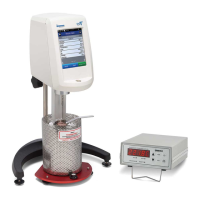
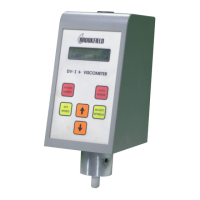
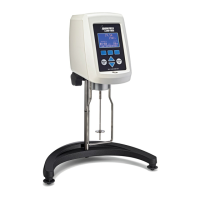
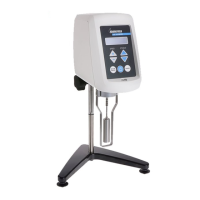
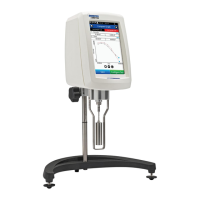
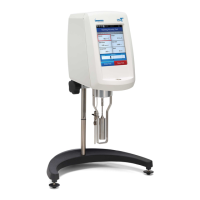

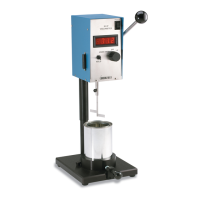
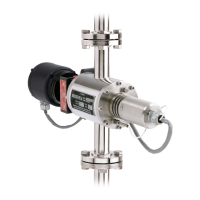


